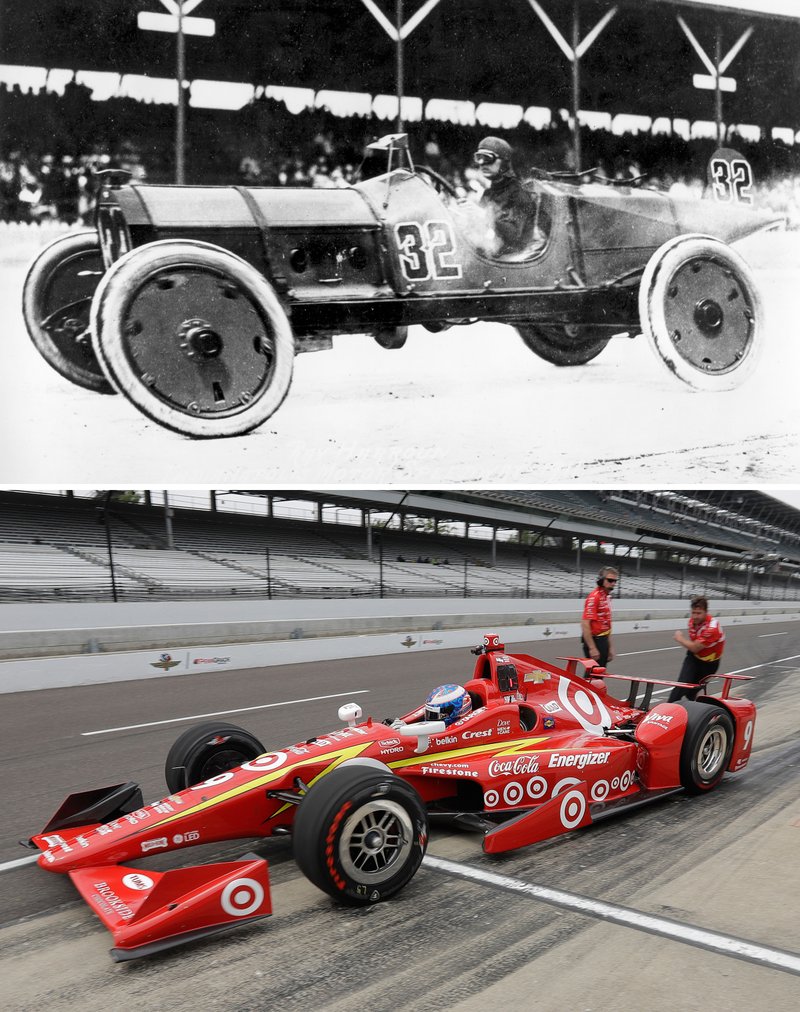INDIANAPOLIS -- Ray Harroun never could have envisioned the speed, science and styling behind the cars on the starting grid for the 100th Indy 500, not when he was piloting the Marmon Wasp to victory in the inaugural race back in 1911.
His black-and-gold car looked like a battering ram on wheels, rather than the sleek, fighter-jetlike cars of today. Harroun puttered around at an average speed of 74 mph, roughly 160 mph behind the pole-winning speed of James Hinchcliffe this year, and he needed nearly seven hours to complete that first 500-mile race.
"In my estimation, the limit is reached at 500 miles," Harroun predicted upon exiting the car, "and is entirely too long for the endurance of the driver."
Yet they're still racing 500 miles after all these years, with the 100th edition taking place today. They probably will be after 100 more years.
Everything else could be vastly different.
"It's a fascinating question because in essence this is why we race: To learn and to develop new technologies to push the performance envelope," said Jim Campbell, vice president of performance vehicles and motorsports for Chevrolet. "I just wish I could live another 100 years to be a part of it."
The high-pitched hum of ethanol-powered engines could be replaced by the nearly silent thrum of electric cars, an idea that might have seemed preposterous a decade ago. Or perhaps they will be solar-powered. Or run on garbage a la the DeLorean in Back to the Future.
"You've got to believe that they'll go with some sort of green technology," said 1986 winner Bobby Rahal, who now runs the Rahal Letterman Lanigan team. "Maybe you'll have nuclear-powered cars. I don't know."
Asking drivers and executives in Gasoline Alley to picture the future of the Indy 500 is like asking Helio Castroneves to play Aldous Huxley or Simon Pagenaud to channel his inner George Orwell. Many of their responses trended toward science fiction.
"You know what? I'm a big Star Wars fan," Pagenaud said, "so maybe it will look like a Star Wars car with no tires. That would be awfully strange, wouldn't it?"
"Maybe they'll look like a spaceship," Castroneves said. "That's a good question. I won't be here. I'll be looking up at the sky. Or hopefully, I should say, I'll be looking down."
Perhaps the changes will be more subtle, like the engine moved elsewhere on the car -- it wasn't until the 1960s that it was moved from the front to the back. If the cars are still stuck to the ground, maybe the tires will be made of some new material -- they already have undergone myriad changes over the years.
Aerodynamics will change. The cars these days seem like they cut through air like a scalpel, but that was probably the case in Harroun's time, too. The car that wins the 100th running today will almost certainly land in the trackside museum, where it will seem woefully antiquated in another 100 years.
"If you go back through history, you see a lot of funny things happen here, a lot of guys getting creative on the engineering side to find that extra tenth of a mile an hour," Hinchcliffe said. "It's pretty standard to see people trying things outside of the box when you're running around this place."
One of the hallmarks of the Indy 500 always has been innovation. Drivers and crews would arrive each May with bold designs and creative engineering, pushing the envelope in new and imaginative ways.
"Where do we go from here? It's an open question," said Art St. Cyr, president of Honda Performance Development. "Advanced fuels? Definitely. Increased safety, of course, would be a major priority. Chassis, where the wheels, tires and suspension are a single unit made out of as-yet undeveloped materials? Perhaps.
"One thing about racing, this is the venue that will continue to push technology."
Not everybody agrees, nor does everyone share the same outlandish optimism for the future.
Three-time winner Bobby Unser lamented the direction the Indy 500 has gone in recent years. He said spec chassis provided by Dallara and engines delivered by Chevrolet and Honda have robbed it of its creativity.
"If they don't change something they're going to kill it -- if they don't change the thing and get back to some real racing and innovation, it's going to kill the race," Unser said with a sigh. "This is America. We're an innovative country. Why would we want everything to be the same?"
Just as many argue the racing has never been better.
Recent years have produced record numbers of lead changes and heart-stopping finishes. The 100th running is sold out, allowing the blackout to be lifted for local TV. Interest appears to be at an all-time high.
"I imagine the rate of change has slowed," Hinchcliffe said, "but the cars will be massively different. The track will have grown a lot. Speeds will get back to record-breaking territory. But I think we'll still have the same awesome event, the same respect and appreciation for it. I wish I could be around to see it."
Sports on 05/29/2016
